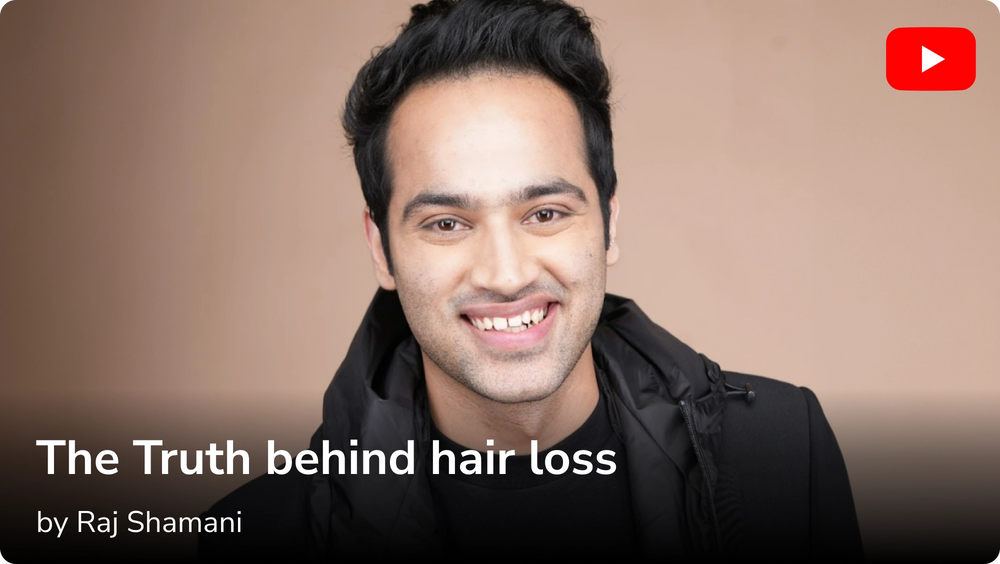Hair fall - just hearing those words can make anyone uneasy, right? We’ve all been there, running our fingers through our hair only to find a small handful left behind. It’s easy to panic and wonder, “How much hair fall is normal?, or am I losing too much hair?”
The truth is, shedding hair is a natural part of life. Our hair goes through a cycle of growth, rest, and renewal, which means losing some strands around 50-100 daily is completely normal. But how much is too much? And when should you start to worry?
In this article, we’ll break it all down for you. From understanding what counts as normal hair fall to spotting the signs of excessive shedding, we’ve got all the answers you need. Whether you’re trying to ease your worries or figure out when to seek help, this article is here to help you navigate your hair journey with confidence. Let’s get started!
Concerned about your hair fall? Take Traya’s Free Hair Test today to uncover the root cause and get a personalized solution tailored to your needs. Let’s get started!
How much Hair Fall is Normal?
While 50–100 strands daily is normal, this number isn't static. Seasonal changes, like monsoon or winter dryness, can naturally cause a slight increase. Also, habits like tight hairstyles or harsh chemical treatments may push this number higher temporarily. But a consistent pattern of losing more than 150 strands across weeks could suggest internal imbalances. Monitoring patterns over a fortnight rather than panicking on a single heavy shedding day offers a more accurate picture.
The Hair Growth Cycle
Interestingly, lifestyle factors can influence this cycle. Poor sleep, crash diets, or hormonal disruptions can shorten the anagen phase, pushing more hair into premature shedding. Maintaining scalp health with gentle massages, balanced nutrition, and stress management can prolong the anagen phase, promoting denser, healthier growth over time.
-
Anagen (Growth Phase):
- Active growth stage lasting 2–6 years.
- 85-90% of your hair is in this phase at any given time.
-
Catagen (Transition Phase):
- A short, 2–3-week phase where hair growth stops.
- 1-2% of your hair is in this phase.
-
Telogen (Resting and Shedding Phase):
- Lasts about 3–4 months.
- 8-10% of your hair rests before naturally shedding.

Key takeaway: If you’re wondering “How much hair fall is normal?” Then shedding 50–100 strands per day is normal because older hairs naturally fall out to make way for new growth.
Factors That Affect “Normal” Hair Fall
The amount of hair you shed daily depends on multiple factors, including your gender, age, and external conditions. Here's how these elements influence hair fall:
-
Hair Length
Longer hair strands appear more prominent when shed. However, the total number of hairs shed is not necessarily higher.
For example, individuals with long hair may notice more hair on brushes or in the shower because the length makes shedding more noticeable, whereas short-haired individuals might not see the same.
-
Gender Differences
Hair shedding patterns differ between men and women due to biological and hormonal factors.
- Women: Normal hair loss per day female is considered to be 50-100 strands but due to hormonal changes like pregnancy, postpartum recovery, and menopause often increase shedding. Stress and styling practices, such as frequent heat usage or tight hairstyles, also contribute to hair fall in women.
- Men: Normal hair loss per day male is also considered to be 50-100 strands. Men are more likely to experience androgenetic alopecia (male-pattern baldness), which causes hair to thin and fall out, especially on the crown and hairline. Hair shedding in men may be less noticeable in volume but more apparent due to localized baldness.
3. Age
As people age, hair follicles spend more time in the resting (telogen) phase and less time in the growing (anagen) phase.
-
Seasonal Shedding
Many people experience increased hair fall during late summer and autumn, a phenomenon called "seasonal shedding." It's the body's natural response to environmental shifts and usually balances out within a few months.
5. Genetics
Genetic predisposition plays a subtle yet strong role. If hair thinning or hair loss runs in the family, you might notice early signs even if your daily care routine is flawless.
This change slows hair growth and can result in thinning over time. Hair also becomes weaker and more prone to breakage as the scalp's natural oil production decreases with age.
Also read: How to Prevent Grey Hair & Hair Loss Due to Scalp Ageing
How to Measure Hair Fall?
It can be difficult to count every single hair you shed daily, but there are simple methods to assess whether your hair loss is within the normal range or if it’s time to seek professional advice.
-
The Pull Test
The pull test is a quick way to assess hair shedding at home. Here’s how to perform it:
- Start with clean, dry hair to avoid any false results caused by tangling or product buildup.
- Isolate a small section of hair (about 50–60 strands) between your fingers.
- Gently tug on this section from the root to the tip.
Results:
- If you see 2–3 strands come loose, this is normal shedding.
- If 10 or more hairs are released with one pull, it may indicate excessive shedding or conditions like telogen effluvium.
This test is not conclusive but can give you an initial indication of whether your hair fall is normal. If the results are concerning, follow up with a dermatologist.
-
The Shower Test
The shower test is another straightforward method that focuses on observing hair loss during washing.
- Wash your hair as you usually would and carefully monitor the number of strands left in the drain.
- Count or estimate the number of hairs visible in the drain and on your hands after shampooing.
What to watch for:
- Losing 50–100 strands during washing is generally normal, especially if you only wash your hair every few days.
- If you notice clumps of hair or more than 150 strands regularly, it could signal issues like telogen effluvium, stress-related shedding, or other medical conditions.
Remember, longer intervals between washes might result in shedding appearing higher as accumulated loose hairs fall out during a single wash.
-
Weekly Monitoring Approach
Instead of daily counting, observe your hair fall weekly. Capture photos of your scalp every 7 days, focusing on the crown and hairline. If you notice progressive thinning or widening of your part, it could signal underlying issues needing professional attention.
When Hair Fall Becomes a Concern?
If your hair feels thinner to the touch or styling becomes difficult due to reduced volume, it's time to act early. Pay attention to sudden textural changes, like hair becoming limp or brittle these subtle shifts often precede visible shedding. Also, if you're experiencing hair fall alongside other symptoms like fatigue, brittle nails, or hormonal acne, it's wise to consult a professional for a holistic diagnosis.
Signs to Watch For
-
Clumps of Hair:
- Finding large clumps of hair on your pillow, hairbrush, or in the shower drain can be a red flag.
- Normal shedding typically involves individual strands, not clumps.
-
Visible Thinning:
- Women may notice a widening of their parting or reduced hair density, especially near the crown.
- This gradual thinning can be a common indicator of conditions like female-pattern hair loss.
-
Bald Spots or Receding Hairlines:
Men often experience patchy bald spots or a receding hairline starting from the temples or crown, which is linked to androgenetic alopecia (male-pattern baldness).
-
Sudden Shedding:
A noticeable spike in hair fall over a short period could indicate stress, hormonal changes, or a reaction to illness or medication.
Also Read: How to Stop Hair Fall and Regrow Hair Naturally ? 12 Best Home Remedies
Common Causes of Excessive Hair Fall
-
Telogen Effluvium:
A temporary condition where more hair follicles enter the resting (telogen) phase due to stress, illness, or sudden lifestyle changes. It often follows events like surgery, pregnancy, or a high fever. -
Androgenetic Alopecia (Male or Female Pattern Baldness):
A hereditary condition that causes gradual hair thinning, usually starting from the crown or hairline in men and from the crown or parting in women. -
Nutritional Deficiencies:
Lack of key nutrients, such as iron, zinc, biotin, and vitamins (like vitamin D), can disrupt hair growth and contribute to hair loss. -
Hormonal Imbalances:
Hormonal fluctuations due to pregnancy, menopause, thyroid imbalances, or conditions like polycystic ovary syndrome (PCOS) can trigger hair shedding. -
Stress:
Chronic stress can lead to hair loss by disrupting the hair growth cycle, often resulting in telogen effluvium. -
Autoimmune Conditions:
Conditions like alopecia areata, where the immune system attacks hair follicles, can cause patchy hair loss. -
Medications and Treatments:
Certain drugs, such as chemotherapy, blood thinners, and birth control pills, can cause hair shedding as a side effect. -
Excessive Hair Styling or Treatments:
Frequent use of heat styling tools, chemical treatments like perms or relaxers, and tight hairstyles (e.g., ponytails) can damage hair follicles and cause breakage or hair loss. -
Scalp Infections:
Fungal infections like ringworm or bacterial infections can lead to hair loss if left untreated. These infections can weaken hair follicles and disrupt normal growth. -
Age:
As you age, hair follicles naturally shrink, resulting in thinner, weaker hair and slower growth. This can lead to noticeable thinning or baldness in both men and women. -
Lifestyle Triggers
-
Poor Sleep Hygiene: Irregular sleep patterns can spike cortisol levels, impacting hair growth cycles.
-
Dehydration: Insufficient water intake affects scalp health, leading to dryness and weakened roots.
-
Excessive Heat Exposure: Prolonged sun exposure or frequent use of heating tools can dehydrate hair shafts and lead to increased breakage.
How to Maintain Healthy Hair?
While some hair shedding is inevitable, adopting healthy hair care habits can help minimize excessive hair fall. Here are key practices to keep your hair in good condition:
-
Daily Care
-
Gentle Shampoo and Conditioner:
Choose products that suit your hair type (e.g., moisturizing, volumizing, or strengthening formulas). Harsh shampoos can strip natural oils, leading to dry or brittle hair. -
Avoid Over-Washing:
Washing your hair too frequently can lead to dryness and weakened strands. Aim to wash every 2-3 days, depending on your hair type and lifestyle. -
Be Gentle When Brushing:
Wet hair is more prone to breakage. Use a wide-tooth comb or a detangling brush to gently remove knots and avoid pulling on the strands.
-
Dietary Improvements
-
Protein-Rich Foods:
Hair is primarily made of keratin, a protein, so it’s essential to consume enough protein in your diet. Include lean meats, eggs, beans, and nuts to support hair growth. -
Omega-3 Fatty Acids:
Incorporate sources of omega-3s like salmon, flaxseeds, and walnuts. These fatty acids nourish the scalp and help maintain healthy hair. -
Vitamins for Hair Health:
Ensure you’re getting enough vitamins A, E, and D, which promote healthy scalp and hair. For example, sweet potatoes, spinach, and eggs are good sources. -
Iron-Rich Foods:
Iron helps carry oxygen to your hair follicles, promoting healthy hair growth. Include spinach, lentils, red meat, and fortified cereals in your meals.
-
Scalp Care
-
Healthy hair starts with a healthy scalp. Use mild exfoliating scalp treatments once a week to remove buildup and improve blood flow to hair follicles.
4. Stress Management
- Incorporate stress-relief practices such as meditation, yoga, or even a short daily walk. Reducing cortisol levels can positively influence hair retention and overall scalp health.
Also Read: Foods that Cause Hair Loss
Also Read: Best Food for Hair growth in Indian
When to Consult a Doctor?
If hair loss is persistent or severe, it’s crucial to seek professional help.
Conditions that require medical attention:
- Rapid hair thinning across the scalp or body.
- Bald patches or noticeable scalp visibility.
- Scalp redness, irritation, or itching.
Diagnostic tests a doctor may recommend:
- Blood tests to check for nutritional deficiencies or hormonal imbalances.
- Take Traya’s Free Hair Test and get to know the root cause of the issue.
Don’t wait until hair loss becomes drastic. Consult a doctor if you notice:
-
Gradual widening of your hair parting.
-
Scalp tenderness or persistent flakiness.
-
Unexplained fatigue or sudden weight changes, as these can signal underlying health concerns linked to hair fall.
Early medical intervention can prevent minor hair shedding from progressing into chronic hair loss.
Key Takeaway
Losing 50–100 strands of hair daily is perfectly normal and part of a healthy hair cycle. However, excessive shedding, visible thinning, or bald patches should not be ignored. Understanding your hair’s natural growth cycle and monitoring changes can help you maintain healthier, fuller hair.
If you’re experiencing unusual hair fall, consult a dermatologist to identify the cause and find an effective treatment plan.
People Also Ask
How much hair loss is unhealthy?
Losing more than 150 strands of hair per day is considered excessive and could indicate underlying issues like stress, hormonal imbalances, or nutritional deficiencies. If hair loss is persistent, leads to visible thinning, or bald spots, it’s important to consult a dermatologist for evaluation and treatment.
Is losing 70 hairs a day normal?
Yes, losing 70 hairs a day is completely normal. Most people shed 50–100 strands daily as part of the natural hair growth cycle. Factors like brushing, washing, and seasonal changes can influence the amount, but this level of shedding doesn’t affect overall hair volume.
Why am I losing 300 hairs a day?
Losing 300 hairs daily is excessive and could be due to telogen effluvium, stress, illness, or deficiencies in nutrients like iron and biotin. Hormonal changes, postpartum shedding, or certain medications can also cause this. Consult a dermatologist to determine the cause and explore effective treatments.
Does fallen hair grow back?
Yes, in most cases, fallen hair grows back as part of the natural hair cycle. However, if hair loss is caused by conditions like androgenetic alopecia or scarring alopecia, regrowth may be limited without proper treatment. Early diagnosis can help improve chances of recovery.
Can you lose 1000 hairs a day?
Losing 1000 hairs a day is not normal and indicates severe hair shedding due to extreme stress, illness, hormonal changes, or medical treatments like chemotherapy. This level of hair loss requires immediate medical attention to diagnose and address the underlying cause effectively.
Does new hair grow every day?
Yes, new hair grows every day. About 85–90% of your hair follicles are in the growth (anagen) phase at any given time, producing new strands. Hair grows approximately 1 centimeter per month, but growth rates vary based on age, genetics, and overall health.
Is hair fall common during weather changes?
Yes, environmental changes — especially during monsoon and winter — can temporarily increase hair shedding due to fluctuations in humidity and temperature.
Can stress alone cause hair fall?
Absolutely. High stress levels elevate cortisol, which disrupts the hair cycle, pushing more hair into the shedding phase.
References
Androgenetic Alopecia
Diet and hair loss: effects of nutrient deficiency and supplement use
Hair Fall: Common Causes and Treatment Modalities
https://www.researchgate.net




















